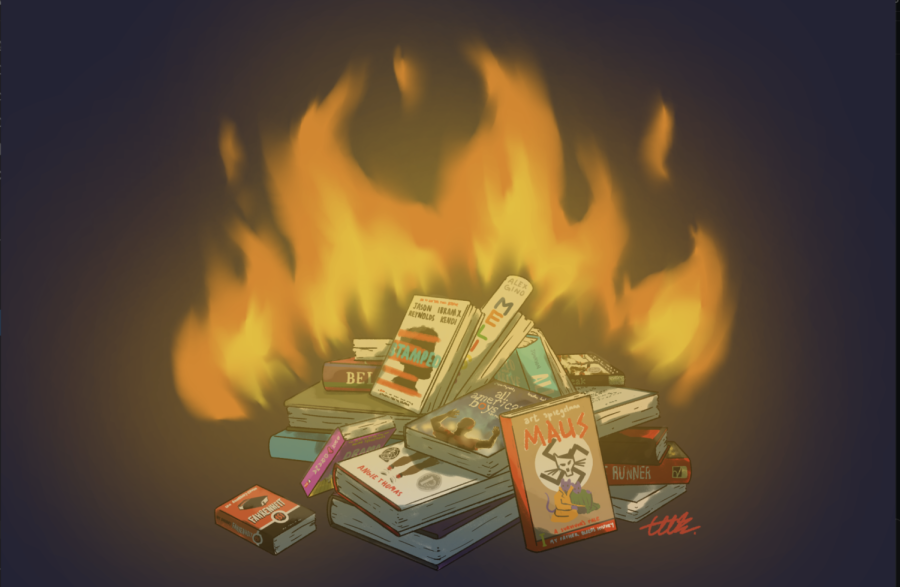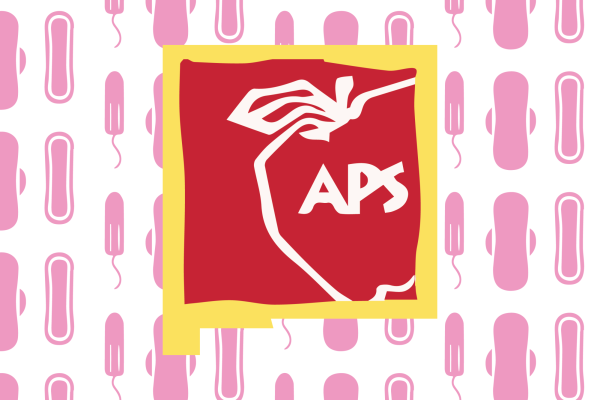Book Banning Rears its Head Again
Understanding the banning of Maus (and other books) in context
Book banning: is censorship justified or a damaging attack on education?
In February 2022, Maus, by Art Spiegelman, a book depicting his account of his family’s struggles throughout the Holocaust, was banned in a rural Tenessee county. It is a graphic novel, with the Jews depicted as mice and the Nazis as cats. A school board in McMinn county voted 10-0 to remove the book from the 8th-grade language arts curriculum because of supposed brief nudity and profanity in the book. All across the country, banning books that fall outside of a very fine line set by school boards and state legislatures has become a common occurrence.
The reasoning made for banning Maus is important to note for many reasons. For one, the book depicts graphic events, and in this instance, the book was removed from the 8th-grade curriculum. For reference, at Albuquerque Academy, the book is taught to 11th and 12th graders. The events depicted are intense and heavy, and whether 8th graders should read the book is up for debate. However, their defense for banning the book is not about the graphic events and heavy nature of the story. It instead identifies brief nudity and profanity as reasoning for the censorship, minuscule details taken in the entire context novel. The first edition of Maus, published in 1980, was an important graphic novel because it opened the doors for future storytelling of serious matters through comic format. It also effectively discusses the Holocaust in a way that opens the reader’s eyes to the subject in a new way.
As society changes, the books we read change as well. In the past ten years, there has been a noticeable push on the part of social advocates for more minority representation in movies, TV, and books. While the progress is slow, there are more books than ever with a diverse cast of characters. According to the Cooperative Children’s Book Center at the University of Wisconsin, “Between 2014 and 2018, the CCBC saw books about African Americans and indigenous people roughly double, and books about Asian Americans and Latinos/Latinas triple. The librarians credit scholars and advocates on social media who are keeping the conversation going, as well as independent publishers…that are dedicated to diversifying literature.” This increase does not stop with racial groups. Books about characters that are LGBTQ+, disabled, and sharing more diverse qualities are also becoming increasingly prominent. While publishers are making progress in representing different communities, the accomplishment needs to be put in perspective. According to the CCBC, “While books about Latinos/Latinas may have tripled, the CCBC has found that they still represent only 6.8 percent of all books. In 2017, a character in a picture book was four times more likely to be a dinosaur than an indigenous child, and two times more likely to be a rabbit than an Asian American child. Only two picture books had a child with a disability as a primary character.”
The legality of book banning is complicated, and local governments give various reasons for banning books. School boards and libraries are at liberty to decide what goes on the shelf at schools and public libraries. Taking the books off the shelf, however, is controversial. Book banning based on the difference of opinion could be deemed a violation of the First Amendment, which guarantees many freedoms to Americans, including that of free speech. The banning of books is deemed acceptable if it is done based on inappropriate language or sexual themes. This is the route most school boards and local governments have taken when banning books. Nonetheless, banning books that include these elements is an indefensible argument. There has been a clear shift from the early 1990s in the motives for book banning. In a 2016 interview with TIME, James LaRue, director of the ALA Office for Intellectual Freedom, said that the recent banning of books is more “‘focused on issues of diversity—things that are by or about people of color, or LGBT, or disabilities, or religious and cultural minorities,” LaRue says. “It seems like that shift is very clear.’”
With the push for progress in diversifying characters and themes in books, there has also been a backlash encouraging the censoring of these books. Censorship has increased dramatically recently, as multiple states take action against specific books, from libraries to classroom environments. The American Library Association reported that the “number of attempts to ban school library books was 67% higher in September 2021 than in September 2020.”
It is all part of a nationwide, majority conservative push to limit what people, especially students, are allowed to read. This effort is being seen throughout the country, as school boards, local, and state governments attempt to limit access to books about and by people in minority groups.
Ever since the banning of Maus, attention has centered around Tennessee, which is one of the states that has taken the most action to ban books on the state level. Laws introduced in Tennessee mirror laws passed in other states, aimed at promoting the ideology of limiting access to education materials that do not adhere to “traditional” norms. According to the American Library Association, 330 books were challenged in the fall of 2021, more than in recent years. This nationwide push has been increasing at historic rates, as more and more states try to frame students’ views about the world we live in. Of the books banned, the three that showed up the most in 2020 were George by Alex Gino, Stamped: Racism, Antiracism, and You by Ibram X. Kendi and Jason Reynolds, and All American Boys by Jason Reynolds and Brendan Kiely. According to the ALA, George was “Challenged, banned, and restricted for LGBTQIA+ content, conflicting with a religious viewpoint, and not reflecting ‘the values of [the shared] community.’” The other books on the list follow a similar pattern, as most of them are about and by minority characters and authors.
There are two prominent exceptions to this right-wing push to limit access to certain books: To Kill a Mockingbird by Harper Lee, and Of Mice and Men by John Steinbeck. The push to limit these two novels comes from the left, as advocates view these two texts as using racial slurs and stereotypes. This argument comes from the basis that older texts which feature these stereotypes and language should be removed to prevent negative impacts on students who read these texts. The censoring of texts for inappropriate stereotypes and language is only one example in a broader debate about whether books that contain racial slurs and stereotypes are to be taught, with some arguing that it is important in order to educate and not repeat history, and others arguing that banning these books is necessary to not repeat racist ideas previously held and racist language previously used.
This push of limiting access to texts is not new. Book banning dates back to Before the Common Era (BCE), when Chinese Emperor Qin Shi Huang burned almost all histories so that he could “rewrite” history and make it seem as if history began with him. Throughout European history, the Catholic Church banned texts going against the rules, teachings, and theology of the church. The most recent resurrection of book banning in history that is widely known to Americans was the book burning and banning that occurred during World War II. The beginning of this new wave of banning surfaced when there was a push for the banning of Toni Morrison’s Beloved in 2012. The string that connects all these events is the intention behind the bannings. While covered up by claims of inappropriate language, themes, and ideas, the underlying intention stays the same: control the public’s narrative and reshape society’s opinions.
America is grappling with an onslaught of efforts to limit access to books that is being felt across the country. While book banning persists, resistance from Americans continues as well. After Maus was banned in McMinn county, it soared to #1 on the Amazon bestseller chart, libraries received numerous donations of the book, and students attempted to get their hands on the graphic novel. According to a CBS News and YouGov poll, “85% of Americans do not think books should be banned from schools if they contain political ideas they disagree with. Similarly, 87% do not support banning books containing discussions of race or slavery. And 83% don’t think books should be banned for criticizing people and events in U.S. history either.” As shown, book bannings are overwhelmingly unsupported by Americans across the political spectrum.
While unsupported, this doesn’t mean that book bannings will cease. As witnessed in America, book banning does not simply cease when a majority of the population is against the practice. It ceases when School Boards, Local and State Governments realize that book banning proves ineffective, as the books that keep on being banned continue to be bought, read, and discussed. If anything is to be learned from history, it is that book banning does not stop the reading of these texts. Instead, it ignites the curiosity of readers across the country.
Author’s Note: If you’re interested in exploring the universe of challenged books, here’s a starter list, composed by a diligent Texas lawmaker, Matt Krause (R-93).

At Albuquerque Academy, William Weinstein ‘23 is a beloved member of the community. This will be his first year involved with The Advocate! He is already...












Miriam • Mar 17, 2022 at 7:26 pm
The idea of banning any book is highly concerning to me. I have read both To Kill a Mockingbird and Of Mice and Men in English class. I understand the arguments against the teaching of books that use racist language, but I believe these negatives can easily be negated by a healthy dose of TEACHING. Instead of shying away from difficult subject matter or language, it is important to put the books into a historical and social context for students. While the use of these slurs and stereotypes is not pleasant to read or deal with, that is really how The South was during the time those novels were written. In order to teach historical literature, it is important to inform students about the reason these words are being used and make clear to them it is NOT ACCEPTABLE to say these words-even in the classroom.